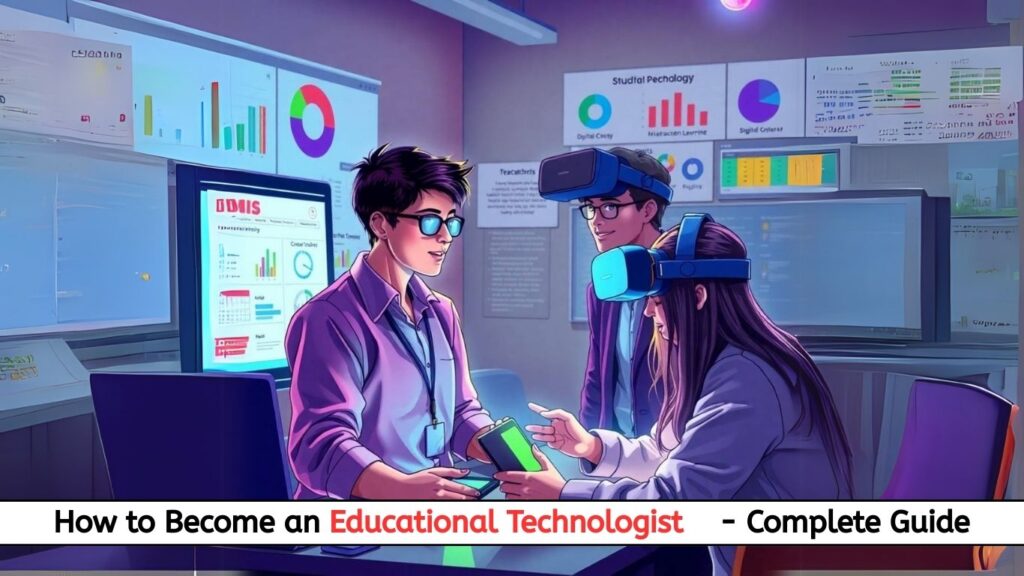
The intersection of education and technology has created one of the most exciting careers of the 21st century—Educational Technologist. As schools, universities, and corporations embrace digital transformation, these professionals are in high demand to enhance learning through technology.
This ultimate guide covers everything you need to know:
✅ History & Evolution of Educational Technology
✅ Salary Expectations (Schools, Corporate, Freelance)
✅ Key Roles & Responsibilities
✅ Essential Qualifications & Skills
✅ Step-by-Step Career Path
✅ Future Trends & Job Outlook
Let’s explore this dynamic field!
1. The History of Educational Technology
Early Foundations (Pre-1900s to 1960s)
- 1920s: First teaching machines (mechanical devices for self-paced learning).
- 1950s-60s: Skinner’s Programmed Instruction and computer-assisted learning (CAL) experiments.
The Digital Revolution (1970s-2000s)
- 1970s: Introduction of PLATO, one of the first computer-based learning systems.
- 1980s-90s: CD-ROMs, multimedia PCs, and the internet transformed education.
- 2000s: Learning Management Systems (LMS) like Blackboard and Moodle became mainstream.
Modern Era (2010s-Present)
- 2010s: Mobile learning (mLearning), gamification, and MOOCs (Coursera, edX).
- 2020s: AI tutors, VR classrooms, and adaptive learning dominate EdTech.
Today, Educational Technologists are critical in K-12 schools, universities, and corporate training.
2. Salary of an Educational Technologist
Salaries vary by experience, sector, and location:
| Experience Level | Average Salary (Annual) |
|---|---|
| Entry-Level (0-2 yrs) | $50,000 – $65,000 |
| Mid-Level (3-5 yrs) | $65,000 – $85,000 |
| Senior-Level (5+ yrs) | $85,000 – $120,000+ |
| Freelance/Consulting | $50 – $150 per hour |
Top-Paying Sectors
✔ Higher Education (Universities) ($60K – $100K)
✔ Corporate Training & L&D ($70K – $110K)
✔ Government & Non-Profit EdTech ($55K – $90K)
✔ K-12 EdTech Integration ($50K – $80K)
Freelancers & entrepreneurs can earn $100K+ by developing custom learning solutions.
3. Roles & Responsibilities of an Educational Technologist
Educational Technologists bridge the gap between pedagogy and technology. Key responsibilities include:
A. Technology Integration in Learning
- Research and recommend EdTech tools (LMS, VR, AI tutors).
- Train teachers and staff on digital learning platforms.
B. Instructional Design & Curriculum Development
- Design blended and online courses using ADDIE/SAM models.
- Develop interactive e-learning modules (quizzes, simulations).
C. Data Analysis & Learning Analytics
- Track student engagement & performance using LMS analytics.
- Optimize courses based on learner feedback & metrics.
D. Accessibility & Digital Equity
- Ensure WCAG compliance for learners with disabilities.
- Promote inclusive EdTech solutions for diverse classrooms.
E. Emerging Tech Implementation
- Pilot AI chatbots, VR labs, and gamified learning.
- Stay updated on future EdTech trends.
4. Qualifications & Skills Required
A. Educational Background
- Bachelor’s/Master’s in Educational Technology, Instructional Design, or Computer Science.
- Certifications like:
- Certified Educational Technology Leader (CETL)
- Google Certified Educator
- ISTE Certification
B. Technical Skills
✔ LMS Platforms: Moodle, Canvas, Schoology
✔ Authoring Tools: Articulate 360, Adobe Captivate
✔ Coding Basics: HTML, CSS (for custom e-learning)
✔ Data Tools: Google Analytics, Tableau
C. Soft Skills
✔ Pedagogical Knowledge (Bloom’s Taxonomy, UDL)
✔ Problem-Solving (Troubleshooting tech issues)
✔ Collaboration (Working with teachers, IT, admins)
5. How to Get Started as an Educational Technologist
Step 1: Build Foundational Knowledge
- Take free courses:
- Coursera – “Foundations of Teaching for Learning”
- edX – “Introduction to Educational Technology”
Step 2: Gain Hands-On Experience
- Volunteer at schools or nonprofits to implement EdTech.
- Intern with e-learning companies or university IT departments.
Step 3: Develop a Portfolio
- Create sample projects (e.g., a gamified lesson, LMS demo).
- Showcase work on LinkedIn or a personal website.
Step 4: Get Certified (Optional but Valuable)
- Google for Education Certified Trainer
- Apple Teacher Certification
Step 5: Apply for Jobs or Freelance
- Job Titles to Look For:
- Instructional Technologist
- EdTech Consultant
- Learning Experience Designer
6. Future Scope of Educational Technology
The global EdTech market will reach $404B by 2025, driven by:
🚀 AI & Personalized Learning (ChatGPT tutors, adaptive assessments)
🚀 Immersive Tech (VR field trips, AR lab simulations)
🚀 Micro-Credentials & Digital Badges (Skill-based certifications)
🚀 Hybrid Learning Models (Blended classrooms post-pandemic)
Job Outlook
- 10-15% growth in EdTech roles by 2030 (BLS).
- High demand in corporate upskilling and K-12 digital integration.
Final Thoughts: Is This Career Right for You?
If you’re passionate about improving education through tech, this career offers impact, innovation, and growth.
💡 Pro Tip: Specialize in AI in education or accessibility tech for an edge.
Ready to Dive In?
📌 Comment below for free resource recommendations!
📌 Share this guide with future EdTech innovators!













Post Comment